In everyday driving, vehicle performance can degrade for various reasons. If you experience a sudden drop in engine power, a sluggish acceleration, a noticeable increase in fuel consumption, or even more serious symptoms like engine misfire, rough idling, or jerking while driving, the root cause might be an ignition system failure. Among the various components of the ignition system, the ignition coil plays a critical role in engine performance. This article aims to provide an in-depth look at the possible causes and diagnostic methods for ignition coil-related issues, helping car owners and technicians identify and resolve these problems effectively.
The Crucial Role of the Ignition Coil in Your Vehicle’s Performance
Before delving into the symptoms and diagnostic procedures, it’s important to understand the function of the ignition coil. The ignition coil is responsible for converting the vehicle’s 12V battery power into the high voltage needed to generate a spark at the spark plug. This spark is essential for igniting the air-fuel mixture within the engine’s cylinders, allowing combustion to take place and the engine to run smoothly.
If the ignition coil fails, the spark plug may not fire correctly, leading to engine misfires, poor acceleration, and inefficient fuel consumption. Regular maintenance and timely replacement of faulty ignition coils can prevent these issues from escalating into more severe engine problems.
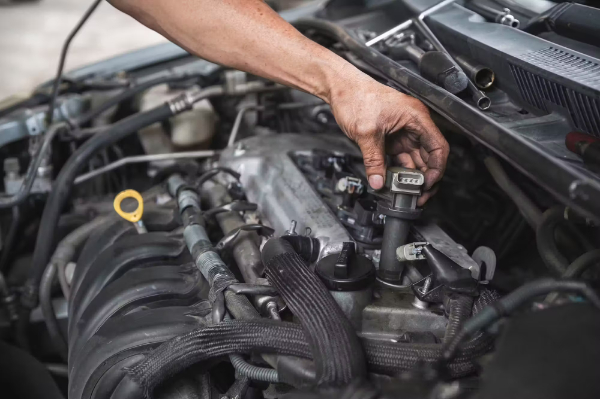
Symptoms of Ignition Coil Failure
Understanding the symptoms of a malfunctioning ignition coil is the first step in diagnosing ignition system issues. Common signs include:
- Engine Misfire: A malfunctioning ignition coil can cause one or more cylinders to misfire, resulting in poor engine performance and potential damage to other components.
- Poor Acceleration: When the ignition coil is not delivering the necessary voltage to the spark plug, acceleration can become sluggish, as the engine struggles to perform efficiently.
- Increased Fuel Consumption: A faulty ignition coil can cause the engine to run inefficiently, leading to an increase in fuel consumption.
- Rough Idling: If the ignition coil is not functioning properly, it can cause the engine to idle roughly, potentially leading to a vibrating or shaking sensation when the vehicle is stationary.
- Check Engine Light: In some cases, the check engine light will illuminate, accompanied by an error code related to the ignition system.
Diagnosing Ignition Coil Failures: Step-by-Step
When diagnosing ignition coil failures, it’s essential to check various components of the ignition system, such as spark plugs, high-voltage wires, sensors, and more. Among these, the ignition coil should be one of the first components to inspect. Here, we’ll explore the common issues that occur within ignition coils and provide guidance on how to identify them.
1. Exterior Signs: Adhesive Leaks, Bloating, or Cracking
Symptoms:
A noticeable indication of ignition coil failure is the appearance of abnormal substances leaking from the ignition coil’s casing. In severe cases, the casing may even bulge or crack. This issue is typically a result of excessive internal heat buildup.
Potential Causes:
- Abnormal Electrical Supply: An issue in the power supply system can lead to overheating and expansion within the coil.
- ECU Control Signal Malfunction: If the ECU (Electronic Control Unit) is sending faulty signals to the ignition coil, it can cause overheating and damage.
- Damaged Wiring or Connectors: A damaged connection in the ignition wiring or a broken ground wire can cause heat buildup, leading to coil failure.
In such cases, it’s crucial to replace the ignition coil to avoid further engine damage.
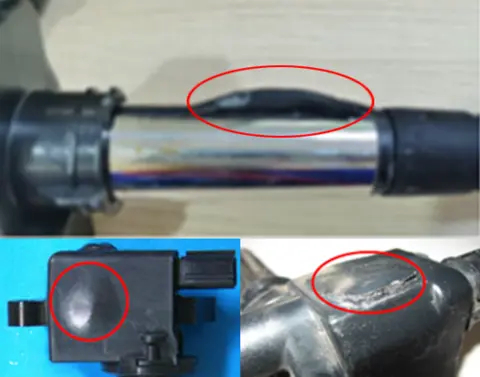
2. High Voltage Connection Erosion or Melting
Symptoms:
The high-voltage connection pipe of the ignition coil may show signs of erosion or, in severe cases, melting. This issue compromises the coil’s ability to transfer the necessary voltage to the spark plug, leading to poor engine performance.
Potential Causes:
- Overheating Engine: An engine running too hot can damage the ignition coil’s components.
- Poor Sealing of Rubber Sheaths: If the rubber seals around the high-voltage connections are compromised, moisture or heat can enter, causing damage to the coil.
- Improper Spark Plug Installation: If the spark plugs are not correctly tightened, it can cause excessive heat to leak into the combustion chamber, leading to issues with the ignition coil.
- Existing Engine Malfunctions: If there are already other engine problems, continuing to drive the vehicle can exacerbate ignition coil issues.
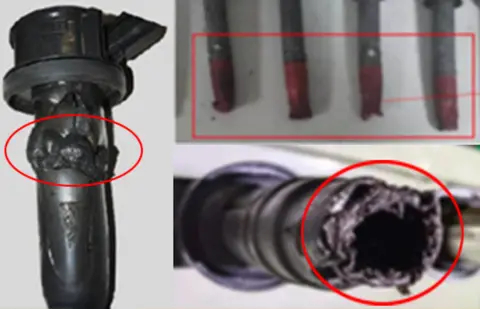
3. Internal Erosion of High Voltage Terminals
Symptoms:
Examine the high-voltage output terminal of the ignition coil for any signs of internal burning or erosion. When this occurs, the coil cannot efficiently transfer the necessary high-voltage energy to the spark plug, leading to ignition failure.
Potential Causes:
- Incorrect Coil Installation: If the coil is not seated properly or the connection is poor, it can cause issues with the high-voltage output.
- Faulty High-Voltage Spring Contact: A loose spring or improper contact between the high-voltage spring and the spark plug can result in incomplete combustion.
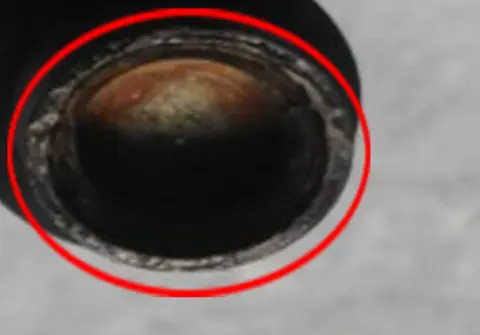
4. Rust and Yellowing on the High Voltage Output
Symptoms:
Rust or yellowing of the ignition coil’s high-voltage output terminal or casing can be an indication of water ingress or moisture exposure.
Potential Causes:
- Water in Spark Plug Holes: If water enters the spark plug wells, it can cause rusting or corrosion of the ignition coil.
- Engine Compartment Leaks: Leaks from the engine cover or faulty seals can allow water to seep into the ignition coil, leading to rust and corrosion.
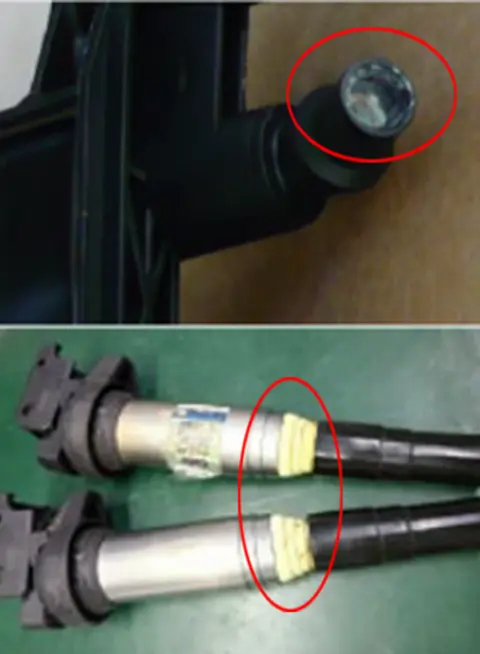
When to Replace the Ignition Coil
If you encounter any of the symptoms mentioned above, or if the ignition coil shows signs of physical damage or wear, it is critical to replace the ignition coil. Even if only one coil is damaged, replacing it ensures that the engine’s ignition system is working properly and efficiently.
Preventing Ignition Coil Failures
While ignition coil failure can sometimes be inevitable, regular maintenance can help prevent premature wear. Here are a few tips to extend the lifespan of your ignition coils:
- Routine Inspections: Periodically check the ignition coil for signs of damage, especially if you experience any of the symptoms mentioned earlier.
- Proper Spark Plug Installation: Ensure that spark plugs are properly installed and tightened to prevent leaks of combustion gases into the ignition coil area.
- Timely Engine Cooling: Keep your engine running at optimal temperatures to avoid excessive heat that can damage the ignition coil.
Conclusion
The ignition coil is an essential component of the vehicle’s ignition system, and its failure can lead to significant engine performance issues, including misfires, poor acceleration, and increased fuel consumption. By understanding the common symptoms of ignition coil failure and knowing how to diagnose potential issues, vehicle owners and technicians can take proactive steps to ensure the engine runs smoothly and efficiently. Regular inspections and maintenance of the ignition system can help prevent costly repairs and improve overall vehicle performance.
For those looking to upgrade or replace their ignition coils, feel free to explore our quality range of automotive products at QPLCAR.com. We offer top-notch parts that will keep your engine running like new.
 >
>